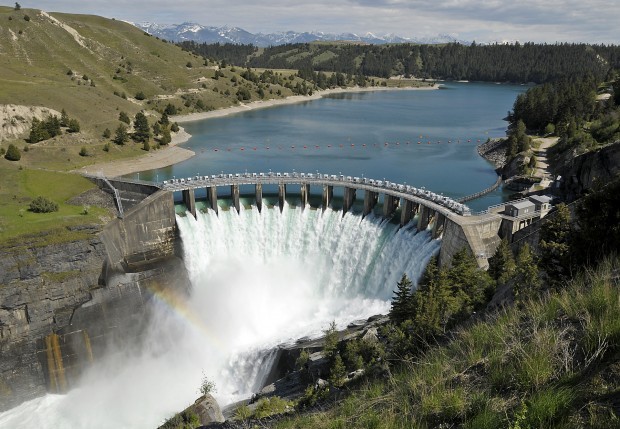There have been some cool articles on the biggest power plants in the world (Forbes – Pentland), and China always tops the chart with its 22,500 MW (megaWatts electric) Three Gorges Dam Hydroelectric Plant.
But that isn’t actually true since it depends on how you define big.
The usual, but somewhat incorrect, measure of what’s biggest is the so-called Nameplate Installed Capacity, which is the maximum power a plant could produce at any moment when everything is running perfectly.
But the real measure of big is what the power plant actually produces. The difference between these two measures is what’s known as the capacity factor. The capacity factor is equal to what the plant, array or farm produces in kilowatt-hours (kWhs) per year divided by what it could produce if it ran at capacity, 24 hours a day, every day for the entire year.
A year has 8,766 hours, and we like to use kWhs for production since that’s what shows up in everyone’s electric bill at the end of the month.
No power plant runs all the time. Sometimes the hydroelectric dam has to ramp down to use the water to assist fish, irrigation or navigation and not use it to produce electricity. Often the sun isn’t shining or the wind isn’t blowing. There are outages for refueling, maintenance, and accidents.
The U.S. Energy Information Administration estimates that utility-scale solar photovoltaic installations in America had an average capacity factor of 27% in 2016, with utility-scale wind farms at 35%, hydroelectric at 38%, coal plants at 55%, combined-cycle natural gas plants at 56% and nuclear plants at 92%.
Last year, Three Gorges Dam generated about 93 billion kWhs each year, instead of the 193 billion kWhs that it could have generated if it had operated continuously, giving it a capacity factor of only 48%.
But Brazil’s Itaipu Dam, with a much smaller Nameplate capacity of 14,000 MW, had a whopping capacity factor of 84% and generated 103 billion kWhs last year, making it the biggest power plant in the world. Three Gorges was in second place.
From this perspective of electricity production, the biggest power plants in the world, and their annual electricity production, are:
Itaipu Hydroelectric Station (Brazil/Paraguay) 103,000,000,000 kWhs
Three Gorges Hydroelectric Plant (China) 93,500,000,000 kWhs
Xiluodo Hydroelectric Station (China) 52,200,000,000 kWhs
Hanul Nuclear Generating Station (S. Korea) 48,160,000,000 kWhs
Bruce Nuclear Generating Station (Canada) 47,630,000,000 kWhs
Hanbit Nuclear Generating Station (S. Korea) 47,620,000,000 kWhs
Guri Hydroelectric Station (Venezuela) 47,000,000,000 kWhs
Surgut-2 Natural Gas Plant (Russia) 39,850,000,000 kWhs
Palo Verde Nuclear Station (United States) 32,846,202,000 kWhs
Xiangjiaba Hydroelectric Station (China) 30,700,000,000 kWhs
Note that the ten largest power plants in the world are split between hydro and nuclear, with only one other source, natural gas, in the top ten.
The Kashiwazaki-Kariwa Nuclear Generating Station in Japan was ranked 3rd in total and 1st in nuclear, producing over 60,000,000,000 kWhs per year before it was unnecessarily closed in 2011 after Fukushima. It could reopen within the next several years depending on political developments.
The world’s biggest solar array is in India at the 950 MW Kurnool Ultra Mega Solar Park. Spread over 24 square kilometers (9 square miles), the array produces a little over 2 billion kWhs per year.
China has also been growing renewables at the fastest rate in the world. Over the last three years, China has installed the equivalent of 3 Three-Gorges-Dam-worth of wind energy. China now has more wind and solar energy than the rest of the world – combined.
So it’s no wonder that the world’s biggest wind farm, the 7,965 MW wind farm at Gansu, is also in China. It produces about 24 billion kWhs per year and covers about 50 square kilometers (19 square miles). It is planned to reach 20,000 MW by 2020 which will be the first time renewables entered the top ten global power producers.
But transmission bottlenecks, coal’s undue influence, and market set-up have prevented large amounts of renewable electricity from reaching the Chinese grid. Last year, 17% of the country’s renewables had to be thrown away, or curtailed. In 2016, almost half of Gansu’s output had to be curtailed as it couldn’t get onto the grid.
This is a global problem. Renewables are increasing faster than the infrastructure to support them.
So it’s not surprising that China would keep building huge hydro plants as well as tripling their nuclear power over the next decade. Along with increasing renewables, it’s the only way to efficiently reduce their carbon footprint quickly enough to make any difference.
But how about the biggest producing natural feature? China just started construction on their second largest power plant, the 16,000 MW Baihetan Hydroelectric Plant along the Jinsha River in the upper Yangtze. Scheduled to come online in 2022, the Baihetan plant will generate about 60 billion kWhs each year for about 100 years, more than enough to power Los Angeles, San Diego and San Francisco combined.
This river already has three other large hydro plantstotaling 30,000 MW, and has a total of 85,000 MW of hydro along its length, making the river the single largest power-producing physiographic feature in the world. When Baihetan comes online, this one river will be producing almost 500 billion kWhs per year.
Only eight countries in the world produce more energy than this single river.



















































